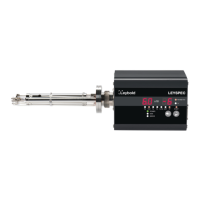300781172_002_C0 - 012/2019 - © Leybold 80
Appendix
Fig. 13.3 Voltage applied to electrode
Equation (2) can be divided into stability analysis in which ions do not exceed a
certain amplitude for an indefinite time and instability analysis in which amplitude
increases with time. Whether Maschew's equation is stable or unstable is a function
of a and q only, and it can be seen from equation (2) that the mass/charge ratio of
ions with which stable oscillation can be performed for U and V voltage values.
When equation (3) is expressed on (U, V) plane as shown in on page 80, both the
x axis and y axis show stable regions in which both axes x and y are stable, and only
ions with a mass/charge ratio that falls in this area can pass through the filter
section.
In order that the U/V ratio constant is constant, a/q is also constant from equation
(2) and a straight line that passes through the origin can be drawn, as shown in on
page 80. Under certain conditions of U/V, all ions of mass/charge ratio are arranged
on this straight line in order of mass number, that is, they pass through the filter
section. As the U/V ratio is increased further, the straight line comes close to the
apex of the stability region and only ions of certain mass numbers can dwell in the
stability region. In other words, the resolution of spectrum becomes high.
This can be summarized as follows: "Apply the voltage in
Fig. 13.2 on page 78 and
sweep voltage while maintaining the U/V ratio at a ratio with which appropriate
resolution can be obtained".
Fig. 13.4 Stability diagram of (U, V) plane and mass scan lines

